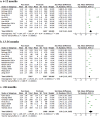Change in Functional Impairment, Disability, and Quality of Life Following Operative Treatment for Degenerative Cervical Myelopathy: A Systematic Review and Meta-Analysis
- PMID: 29164033
- PMCID: PMC5684851
- DOI: 10.1177/2192568217710137
Change in Functional Impairment, Disability, and Quality of Life Following Operative Treatment for Degenerative Cervical Myelopathy: A Systematic Review and Meta-Analysis
Abstract
Study design: Systematic review.
Objectives: The primary objective of this systematic review was to define the change in impairment, disability, and pain following surgical intervention in patients with degenerative cervical myelopathy (DCM). Secondary objectives included to assess the impact of preoperative disease severity and duration of symptoms on outcomes and to summarize complications associated with surgery.
Methods: A systematic literature search was conducted to identify prospective studies evaluating the effectiveness and safety of operative treatment in patients with DCM. Outcomes of interest were functional status, disability, pain, and complications. The quality of each study was evaluated using the Newcastle-Ottawa Scale, and the strength of the overall body of evidence was rated using guidelines outlined by the Grading of Recommendation Assessment, Development and Evaluation (GRADE) Working Group.
Results: Of the 385 retrieved citations, 32 met inclusion criteria and are summarized in this review. Based on our results, pooled standard mean differences showed a large effect for improvement in Japanese Orthopaedic Association or modified Japanese Orthopaedic Association score from baseline at short-, medium-, and long-term follow-up: 6 to 12 months (1.92; 95% confidence interval [CI] = 1.41 to 2.43), 13 to 36 months (1.40; 95% CI = 1.12 to 1.67), and ≥36 months (1.92; 95% CI = 1.14 to 2.69) (moderate evidence). Surgery also resulted in significant improvements in Nurick, Neck Disability Index, and Visual Analogue Scale scores (low to very low evidence). The cumulative incidence of complications was low (14.1%; 95% CI = 10.1% to 18.2%).
Conclusion: Surgical intervention for DCM results in significant improvements in functional impairment, disability, and pain and is associated with an acceptably low rate of complications.
Keywords: complications; degenerative cervical myelopathy; outcomes; severity; surgery.
Conflict of interest statement
Declaration of Conflicting Interests: The author(s) declared no potential conflicts of interest with respect to the research, authorship, and/or publication of this article.
Figures





References
-
- Cowan JA, Jr, Dimick JB, Wainess R, et al. Changes in the utilization of spinal fusion in the United States. Neurosurgery. 2006;59:15–20. doi:10.1227/01.NEU.0000219836.54861.CD. - PubMed
-
- Patil PG, Turner DA, Pietrobon R. National trends in surgical procedures for degenerative cervical spine disease: 1990-2000. Neurosurgery. 2005;57:753–758. - PubMed
-
- Rhee JM, Shamji MF, Erwin WM, et al. Nonoperative management of cervical myelopathy: a systematic review. Spine (Phila Pa 1976). 2013;38:S55–S67. doi:10.1097/BRS.0b013e3182a7f41d. - PubMed
-
- Nouri A, Tetreault L, Singh A, Karadimas SK, Fehlings MG. Degenerative cervical myelopathy: epidemiology, genetics, and pathogenesis. Spine (Phila Pa 1976). 2015;40:E675–E693. doi:10.1097/BRS.0000000000000913. - PubMed
Publication types
LinkOut - more resources
Full Text Sources
Other Literature Sources
Miscellaneous

